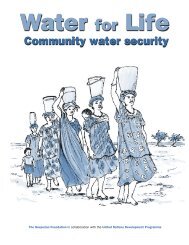A Sourcebook - UN-Water
A Sourcebook - UN-Water
A Sourcebook - UN-Water
Create successful ePaper yourself
Turn your PDF publications into a flip-book with our unique Google optimized e-Paper software.
12.1 Defining Expected Improvements<br />
To monitor progress against expectations, there must be clarity on expected results. Sector practitioners<br />
should recognize variability in country’s abilities and circumstances and focus on the area where<br />
what should be done, what the country can do, and what the practitioner can influence coincide,<br />
with the aim of expanding this area of overlap over time (see Figure 12.2)<br />
It follows that before designing a monitoring and evaluation program, practitioners must be clear<br />
about:<br />
• What are the inputs or interventions whose success is to be monitored?<br />
• What are the hoped for results?<br />
• What is the expected chain of causation between the inputs and the hoped for result?<br />
In the example illustrated in Figure 12.1, the actions involve strengthening planning capacity, bringing<br />
in e-Procurement, and involving third parties in supervising procurement and construction. The hoped<br />
for chain of causation is that these measures would improve planning and reduce corruption in capital<br />
works. The desired result is that more appropriate capital works are procured and that the cost of<br />
the works is lower, while the quality is higher. Ultimately it is hoped that this would reduce the cost and<br />
increase the quality of water and sanitation services.<br />
12.2 Choosing Suitable Indicators<br />
To monitor progress, practitioners will need something that can be observed and measured, that correlates<br />
well with the intended results of the program—in other words, a suitable indicator. Box 12.1 indicates<br />
how important this choice is.<br />
Part II of the sourcebook lists numerous indicators that may be suitable for detecting corruption or assessing<br />
governance. In selecting which indicators are suitable for monitoring purposes, practitioners<br />
may consider the following principles:<br />
Figure 12.2 Recognizing Variability in Country’s Abilities and Circumstances<br />
Work on this<br />
What shouldbe<br />
done<br />
What the<br />
country can do:<br />
• Capacity<br />
• Political<br />
economy<br />
• Other<br />
constraints<br />
Expand the middle area<br />
over time<br />
What practitioner can<br />
influence<br />
147
















